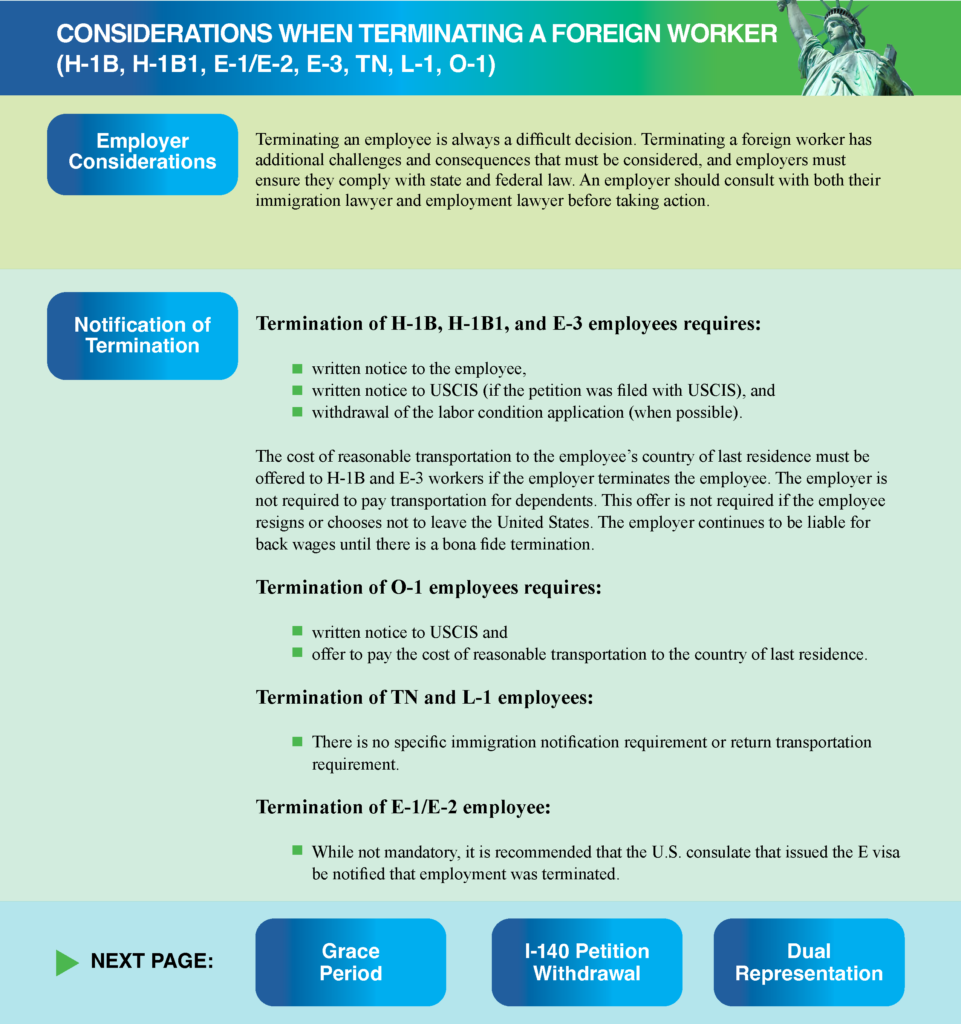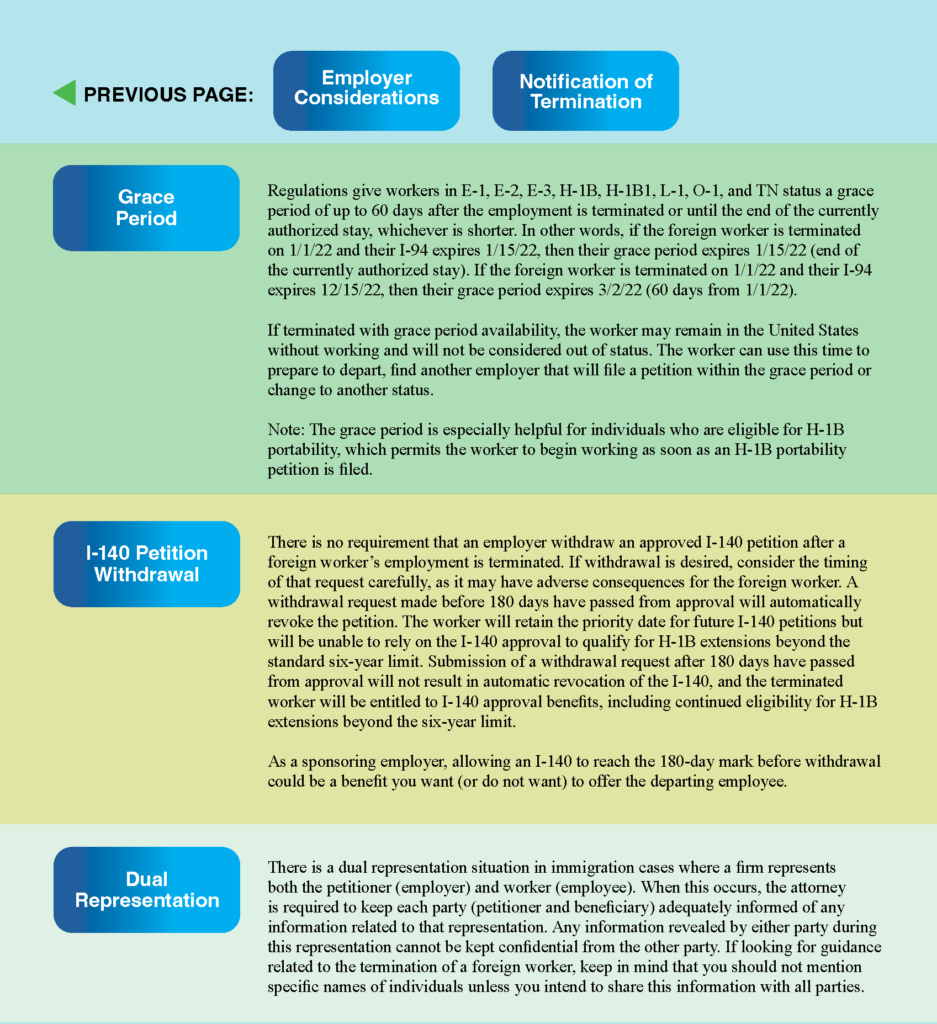Update, December 8, 2022
Considerations from the employer’s perspective when terminating a foreign worker.


Original Post, February 15, 2021
We often receive inquiries from clients and first-time callers who just got terminated or have been informed about their last day. Many of them hope for a quick fix but fail to grasp the reality of what is ahead. Only after expectations are properly calibrated, may they begin to plan for their next steps effectively. This article serves to provide a broad overview of some of the most common questions.
60-Day Grace Period
As of January 2017 and pursuant to the Final Rule titled “Retention of Eb-1, EB-2, and EB-3 Immigrant Workers and Program Improvements Affecting High-Skilled Nonimmigrant Workers,” H-1B beneficiaries can benefit from a 60-day grace period starting on the date of termination. During this period of lawful presence, the beneficiary may find a new H-1B employer to file an H-1B transfer petition on their behalf (the receipt of which by USCIS further extends their lawful status until adjudication), change status to another nonimmigrant status (for example H-4), or depart the country.
The 60-day grace period starts on the date of the cessation of employment. We often get asked whether it can be adjusted or pushed back. Ultimately, this is the employer’s decision. The final decision may be impacted by last-minute work assignments, leftover PAL, or unique situations, such as when an H-4 dependent is about to complete the visa application process overseas, and adding a few more days may allow him/her to return to the US in valid H-4. Most employers are reasonable and can afford some minor adjustments to the termination date. But keep in mind that the whole point of having this grace period is to give beneficiaries that much-needed flexibility to find ways to continue their stay in the U.S. and avoid a sudden disruption to their livelihood.
Interestingly, the 60-day grace period also applies in situations when the decision to terminate was made by the employee. Although it was created out of concern for those who were suddenly let go by their employer, the rule only mentions “cessation of employment.” As such, a beneficiary may decide to quit on their own, which leads to a “cessation of employment,” and therefore benefit from the grace period during which they will be hunting for a new job and hopefully become the beneficiary of a new H-1B filing prior to the end of the grace period. But note that the preferred practice for changing H-1B employment is to secure a new H-1B employment first before submitting that 2-week notice. That way, you are not bounded by any time constraints and get to keep your old job if things don’t work out. Of course, if you can’t stand your job and must quit at all costs, then know that the 60-day grace period will provide some relief.
So how does USCIS know when the H-1B beneficiary is terminated? It’s far from being automatic. By law, employers must inform USCIS in writing whenever an H-1B employee is no longer working there. The letter is generally mailed to USCIS, and it can sometimes take months for USCIS to actually process the letter and issue a confirmation of the termination date in a letter. But this does not mean that employees should take advantage of this delay and enjoy a longer grace period. First, any subsequent H-1B filing will require evidence of lawful status which means recent pay stubs. For instance, if your last pay stub was issued in January and your H-1B transfer was filed in May, then the lack of a more recent pay stub would raise an alarm. Second, USCIS will someday know about the date of termination, and even if your subsequent H-1B gets approved, USCIS may, in the future, discover a contradiction and decide to revoke your new H-1B. It’s therefore always better to act in good faith based on what you know rather than take risks with how likely USCIS will know or when USCIS will know about a damaging fact.
I-140
For beneficiaries with an approved I-140, a common question is, “Can I transfer my I-140 to a new employer?” I-140 is the employer’s petition, so the beneficiary cannot individually do anything to the approved petition. There is a benefit, however, in terms of keeping your priority date (PD). The PD basically marks your place in line for applying for a green card. If you’ve already waited 3 years in line, those 3 years will not be wasted when you change employer if your PD is preserved. The new employer still must restart the process beginning with PERM and then I-140. But if the new I-140 is approved, it will preserve the same PD as your first I-140. In short, although you can’t transfer an approved I-140, you can transfer the PD to the new I-140 filed by the new employer, provided that the underlying process proves successful.
An often followed-up question may be, “What happens if my current employer withdraws the approved I-140?” This was more of an issue many years ago when there were reports that some IT firms regularly withdrew an approved I-140 whenever a beneficiary leaves the company. At the time, the impact was devastating. The affected employee would not only have to go through the employment-based green card process again from the beginning with a new employer, but there was no transferring of PD. So, effectively, everything started from the beginning for that individual.
The current rule offers some relief. If the employer withdraws the I-140 before 6 months have passed, the beneficiary will still retain the priority date for future I-140 petitions but cannot rely on the withdrawn I-140 to qualify for H-1B extensions beyond the 6 years. If the employer seeks to withdraw the I-140 more than 6 months after approval, the beneficiary will retain both I-140 benefits – priority date retention and extension beyond the 6-year max. Most employers do not withdraw I-140 out of spite, and the practice is rare, especially right after I-140 approval. But with the 6-month rule, the key benefit of an approved I-140 will likely “transfer” with the departing employee.
Other nonimmigrant status
It’s not always possible to find a new employer willing to file H-1B during the 60-day grace period. Beneficiaries in those situations facing the end of their grace period often ask about other nonimmigrant status options that they may change into temporarily. The most common types are H-4, F-1, or B-2. H-4 is the best choice for those whose spouse is also in H-1B status. They may qualify for H-4 EAD if their H-1B spouse also is the beneficiary of an approved I-140. Under Biden, H-4 EAD is no longer under attack and is expected to be a safe option for someone looking for an H-1B replacement. F-1 may provide an extended stay in the US as long as they are willing to enroll in a qualified school program. B-2, although generally associated with tourists, would allow someone who lost their H-1B employment to stay at most 6 more months to wind down their affairs in the U.S. The idea is you need to take care of things before leaving the country.
However, do not think of B-2/F-1 as a reliable stepping stone for you to buy more time so that you may one day transition into H-1B. The issue lies in intent. When you request change of status to F-1/B-2, you are telling USCIS that you want to go to school or be a visitor temporarily. Your intent will be questioned if a subsequent H-1B petition is filed soon after. For example, assume you were fired on February 1st. Because you weren’t able to find a new H-1B employer prior to the 60-day grace period, you then file to change status to B-2 on March 20. Miraculously, you get an offer on April 5th which you immediately accept and the new H-1B employer files H-1B petition on your behalf on April 15th. Now both H-1B and B-2 are pending. In order to adjudicate H-1B, the B-2 must first be adjudicated. USCIS may, in this case, deny your B-2 because the subsequent H-1B filed so soon after contradicts your intent to stay temporarily in the U.S. If that happens, you will not be allowed to stay in the US and change to H-1B because you’ve failed to maintain status. The H-1B petition may still be approved substantively but you will only attain H-1B status via consular processing.
Let’s tweak the example above a bit and assume that the H-1B was filed on June 3rd. Now it becomes harder for USCIS to question the initial intent behind the B-2 filing since the H-1B was filed many months later. A person’s intent is allowed to change, but it’s when the change happens so quickly in the future that it impacts a pending nonimmigrant application. Because the intent changed many months in the future, the B-2, in this case, will likely be approved, and if the subsequent H-1B petition was also approved, you would change to H-1B inside the U.S. without having to go through consular processing.
In summary, changing to another nonimmigrant status may buy you more time after the grace period ends but may not be a reliable path for getting back to H-1B because the underlying intent for seeking temporary nonimmigrant status may be questioned by the reviewing officer if at some point a new employer files H-1B for you.
